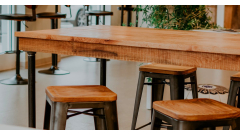When it comes to enjoying a fine bottle of wine, the details matter. Selecting the right cork for your wine bottles can elevate the experience and ensure that every sip is as exquisite as the last. Whether you're a seasoned winemaker or a casual enthusiast, understanding the nuances of cork choice is essential for preserving the integrity of your wine.
This guide will walk you through the considerations involved in choosing the perfect cork – from materials to styles, and everything in between. Get ready to unlock the secrets of cork selection and enhance your wine-bottling skills, ensuring that your treasured vintages remain protected and delightful!
The FastRack 45-CZ-85-D6BG Wine Bottle Floor Corker is designed for both efficiency and quality, catering to wine enthusiasts who value secure closures for their bottles. Made from sturdy Portuguese Red cork and steel, this corker ensures the perfect seal that keeps your wine tasting fresh. Its user-friendly design makes the corking process smooth and straightforward, making it an essential tool for winemakers looking to preserve the distinct flavors of their creations.
Cork Types Overview
When selecting the right cork for your wine bottles, understanding the different types of corks is essential. Each type offers unique characteristics that can significantly influence the aging process and overall quality of your wine. The main cork types include natural cork, synthetic cork, and agglomerated cork. Each type caters to various winemaking goals and preferences, so knowing their benefits and drawbacks can help enhance your wine bottling experience.
Natural corks are made from the bark of the cork oak tree, renowned for their ability to allow minimal oxygen transfer while effectively sealing the bottle. They are favored for premium wines due to their ability to age well, but they do carry risks of cork taint and variability in quality. Synthetic corks, made from plastic materials, provide consistency and eliminate the risk of cork taint, making them an attractive option for those bottling wines for early consumption. However, they may not be suitable for long-term aging. Agglomerated corks combine natural cork bits and binding agents, providing a more economical alternative. They can offer good sealing and lower cork taint risks, but they may not breathe as well as pure natural corks. Each cork type comes with its intricacies that can significantly influence your wine's aging and flavor profile, so consider the specific needs of your wine when making your selection.
- Natural Cork: Great for aging, natural properties, but risks of cork taint.
- Synthetic Cork: Consistent, taint-free, suitable for early drinking, but may not allow aging.
- Agglomerated Cork: Economical, good sealing, lower risk of taint, but may not breathe as well.
Choosing Cork Size
Selecting the right cork size is essential for ensuring that your wine, particularly when using the FastRack 45-CZ-85-D6BG Wine Bottle Floor Corker, is sealed properly. Different bottle necks accommodate various cork sizes; therefore, understanding these measurements can preserve the wine’s integrity and flavor for an extended period. A cork that is too small may allow air to enter, leading to oxidation and spoilage, while a cork that is too large can cause excessive pressure and potential breakage during insertion or removal.
To determine which cork size you need, begin with measuring the diameter of the bottle opening using calipers or a ruler. Standard cork sizes typically range from 38mm to 44mm in length and can vary in diameter from 22mm to 25mm. Once you have your measurement, consult the standard cork size chart to find a compatible cork that matches your bottle's neck size. This ensures a snug fit, providing an effective seal for your wine. Remember:
- Exact measurements lead to better sealing.
- Check bottle neck dimensions for compatibility with typical cork sizes.
- Consider natural vs. synthetic corks depending on the desired preservation duration.
Cork Source Quality
The quality of cork plays a vital role in the preservation and aging of wine. High-quality corks, typically sourced from reputable suppliers, provide an optimal seal that prevents oxygen from entering while allowing minute gas exchanges essential for the wine's development. In the case of the FastRack 45-CZ-85-D6BG Wine Bottle Floor Corker, using premium corks ensures that the fine Portuguese red wine remains protected from spoilage and off-flavors, allowing the wine to mature gracefully. The properties of the cork, such as density and porosity, directly influence how well the wine will age over time.
When sourcing corks, it is crucial to look for suppliers known for their commitment to quality. Establishments that specialize in natural cork from the Mediterranean regions often have the best reputation, as the climate and soil contribute to the sustainability of the cork oak trees, which produce high-quality materials. Before using any cork, checking for defects is paramount. Look for:
- Cracks or splits that could compromise the seal
- Uneven surfaces that may lead to faulty corking
- Off odors that may indicate spoilage or contamination
- Excessive brittleness, which might indicate age or damage
Using top-tier corks not only enhances the integrity of the bottle but also reflects the care and respect for the wine inside it.
- Select corks that are uniform in color and texture for a consistent sealing experience.
- Prioritize suppliers who adhere to sustainability practices, ensuring the long-term availability of quality cork.
Preparing Corks for Use
When using the FastRack 45\-CZ\-85\-D6BG Wine Bottle Floor Corker, ensuring that your corks are primed for sealing your bottles is essential. Cleanliness is paramount in wine bottling; any contamination can spoil your carefully crafted wine. Begin by inspecting your corks. Look for signs of mold or damage. If the corks are dry or have been stored for an extended period, their integrity could be compromised, which may introduce unwanted flavors or defects into your wine.
Sanitizing is the next vital step. Soak your corks in warm water for about 10-15 minutes. This process not only softens the corks, making them easier to insert but also helps remove any dust or residues. After soaking, prepare a sanitizing solution using a no-rinse sanitizer specifically designed for winemaking. Dip the corks in this solution to eliminate any lingering bacteria. Allow them to dry on a clean surface before using them with the FastRack corking device to maintain their pristine quality.
- Inspect corks for mold or damage before use
- Soak corks in warm water for 10-15 minutes
- Utilize a no-rinse sanitizer to ensure thorough cleansing
- Allow corks to dry properly before bottling
Techniques for Inserting Corks
Using the FastRack 45-CZ-85-D6BG Wine Bottle Floor Corker provides a reliable method for sealing your wine bottles with precision. Begin the process by ensuring that your bottles are thoroughly cleaned and dried, as residue can interfere with the corking process. Pre-measure the corks you wish to use, ensuring they are compatible with the bottle size and type. Place the cork in the corker’s cup, ensuring it is seated properly, so it remains aligned during insertion.
To insert the cork, position the bottle securely within the corker. Employ your body weight to press down on the lever. This is essential for achieving the necessary pressure to fully insert the cork without damaging it. Maintain consistent pressure while ensuring the cork is pushed down evenly into the neck of the bottle. For a perfectly flush fit, observe the bottle and make minor adjustments as required during the corking motion. When fully inserted, the cork should sit just below the lip of the bottle, preventing any air from entering or affecting the wine inside. Utilize the following tips for optimal results:
- Check the cork for any cracks or imperfections before inserting, as damaged corks can lead to leaks.
- Keep the corker clean, as debris can affect the mechanism and the corking process.
- Use a light coating of food-grade lubricant on the cork to ease the insertion process, especially with tighter bottles.
Preventing Cork Breakage
To ensure a smooth corking process with the FastRack 45-CZ-85-D6BG Wine Bottle Floor Corker, attention to the condition of your cork and the amount of pressure applied is essential. The right cork, especially ones made from Portuguese red cork, needs to be in excellent condition to prevent breakage. Inspect your corks for any signs of damage, such as cracks, brittleness, or dryness. A damaged cork is more susceptible to breaking during insertion. Select corks that have a slightly moist feel, as this can help facilitate a smoother insertion. Corks that are too dry may crumble, while overly moist corks can become too pliable, creating a risk for breakage if not used correctly.
In addition to cork condition, adjusting the corking pressure is crucial when using a floor corker like the FastRack model. Begin with a gentle, steady pressure that allows the cork to enter the bottle without excessive force. Rushing the corking process or applying too much pressure too quickly can lead to unintended breakage. It’s advisable to practice on a few bottles first to get a feel for the optimal pressure needed. Always align the cork properly to ensure it enters straight, as misalignment can cause additional stress on the cork.
- Inspect corks for damage before use.
- Maintain an appropriate moisture level in corks.
- Start with gentle pressure on the corking lever.
- Align corks straight for insertion.
Storage of Corks
Choosing the right storage method for corks is essential to preserving their quality and functionality. For the FastRack 45-CZ-85-D6BG Wine Bottle Floor Corker, ensuring that your corks remain in optimal condition before you seal your bottles is crucial. Start by selecting a cool, dry, and dark environment for storing your corks. Ideally, the temperature should be maintained between 50°F to 70°F. Fluctuating temperatures can cause the corks to expand and contract, potentially leading to degradation. Humidity levels should ideally hover around 50% to 70%; this balance prevents the corks from drying out or becoming too moist, both of which can compromise their seals.
Light exposure can also impact cork quality. Storing corks in a dark place shields them from UV rays, which can break down the natural materials in the cork, leading to faults in wine preservation. Use airtight containers or bags to protect your corks from external elements like dust and moisture. Additionally, avoid stacking corks on top of each other, as the pressure may deform them. Following these principles will ensure the integrity and longevity of your corks for your wine bottling needs.
- Keep corks in a cool, dry place.
- Aim for a temperature between 50°F and 70°F.
- Maintain humidity levels around 50-70%.
- Store corks in dark environments to avoid UV damage.
- Use airtight containers to protect from moisture and dust.
Cork Maintenance Tips
Maintaining corks in bottles after corking is essential to preserving the quality of your wine. The FastRack 45-CZ-85-D6BG Wine Bottle Floor Corker is a fantastic tool for sealing your bottles, but the real work begins after you've corked them. Proper storage conditions play a vital role in keeping corks intact and your wine in optimal condition. Always store your bottles horizontally. This keeps the cork in contact with the wine, preventing it from drying out. A dry cork can lead to oxidation, compromising your wine's flavor and aroma.
Temperature is another critical factor. Aim for a consistent storage environment between 50°F and 60°F (10°C to 15°C). Avoid areas with temperature fluctuations or direct sunlight, which can degrade the cork material over time. A wine cellar or a dedicated wine fridge maintains the ideal conditions. Additionally, avoid handling the bottles too much after corking. When moving bottles, hold them by the base instead of the neck to minimize agitation and reduce the risk of displacing the cork, which can cause leaks.
- Store bottled wine horizontally to keep corks moist.
- Maintain a consistent temperature around 50°F to 60°F.
- Avoid direct sunlight exposure during storage.
- Handle wine bottles by the base to prevent cork displacement.
Recognizing Cork Flaws
Cork plays a crucial role in preserving the quality of your wine, and recognizing cork flaws can save you from unpleasant surprises down the line. The FastRack 45-CZ-85-D6BG Wine Bottle Floor Corker, designed for ease of use, can ensure proper sealing, but understanding defects in corks is essential even before they go into the bottles. One of the most notorious flaws to watch out for is TCA contamination, which can result in a musty aroma and ruin the wine's flavor profile. Whenever you handle corks, check for unusual odors—if a cork smells like wet cardboard or damp basement, it might be tainted by TCA or other harmful compounds.
In addition to TCA, inspect corks for physical defects that may compromise their ability to seal bottles effectively. Look for any signs of mold, which can indicate improper storage conditions, and check for breakage or cracks that could lead to a leak. A cork that is too dry may crumble when inserted, while one that is too moist might prevent a proper seal. Pay attention to the color and texture; a healthy cork should be light tan, with a smooth feel. Shiny or overly soft corks could indicate aging issues. Remember to consider these factors before using your FastRack corker to ensure your wine maintains its intended quality.
- Conduct a smell test for musty odors indicating TCA contamination.
- Inspect for mold, cracks, and other physical defects.
- Assess the cork's color and texture for signs of aging or decay.
Corking for Aging Wines
When it comes to aging wines, choosing the right cork is essential for preserving the wine’s quality and enhancing its flavor profile over time. The FastRack 45-CZ-85-D6BG Wine Bottle Floor Corker, crafted from durable steel, excels in providing a reliable corking solution for wine bottles that are intended for prolonged aging. One of the primary considerations is the cork's ability to allow for a minimum amount of oxygen transfer, which is crucial for the aging process. A well-structured cork can facilitate this delicate balance: it permits small amounts of oxygen to enter the bottle, fostering the slow oxidation that adds complexity and depth to the wine, while still maintaining a secure seal to prevent leakage and contamination.
Another vital aspect is ensuring that the cork creates a tight seal that protects the wine from external influences. A cork that fits snugly prevents undesirable elements, such as air and light, from compromising the wine's integrity. The FastRack corker is designed to compress and insert the cork with precision, ensuring that each bottle meets these standards for a consistent and effective seal. When selecting corks, it’s also beneficial to consider the following:
- Quality of cork material: Natural cork is often preferred for aging due to its elasticity and ability to expand and contract as needed.
- Length and diameter: Ensure the cork fits your specific bottle type to prevent the risk of leakage.
- Storage environment: Maintain a consistent temperature and humidity to complement the cork's performance over time.
Why We Chose This Product
In wrapping up this guide, it's clear that choosing the right cork is pivotal for your wine's journey from bottle to glass. The FastRack 45-CZ-85-D6BG Wine Bottle Floor Corker stands out for its reliability and ease of use, making it an excellent choice for anyone who wants to take their wine bottling to a new level. This tool streamlined the corking process while ensuring a tight seal, which is essential for maintaining flavor and aroma.
- Durable Portuguese Red cork material
- Well-constructed steel design for longevity
- Easy handling for flawless corking
- Enhances wine preservation
By incorporating the FastRack corker into your wine bottling process, you're not just investing in a product, but in the quality of your wine. Let's keep those cherished vintages safe and flavorful!
The FastRack 45-CZ-85-D6BG Wine Bottle Floor Corker is designed for both efficiency and quality, catering to wine enthusiasts who value secure closures for their bottles. Made from sturdy Portuguese Red cork and steel, this corker ensures the perfect seal that keeps your wine tasting fresh. Its user-friendly design makes the corking process smooth and straightforward, making it an essential tool for winemakers looking to preserve the distinct flavors of their creations.










